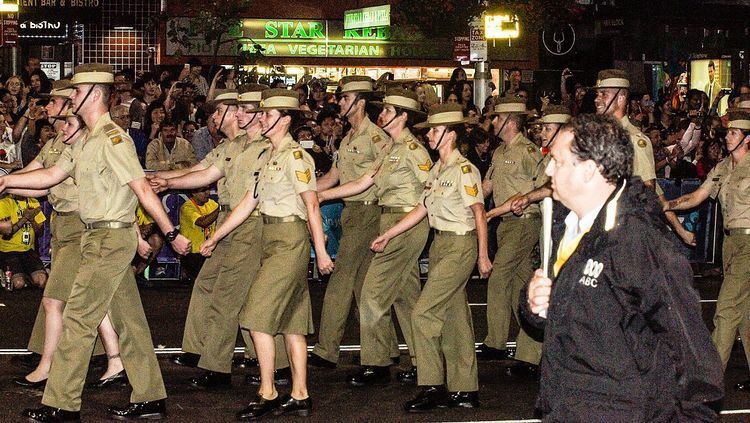 | ||
Australia has allowed gay and lesbian personnel to serve openly in the Australian Defence Force since 1992.
Contents
Since 1 January 2009, domestic partners of LGBT personnel have had the same access to military retirement pensions and superannuation as opposite-sex couples.
Australia also permits transgender people to serve openly. Lieutenant Colonel Cate McGregor is the most senior transgender person in the army.
History
In 1982, the Department of Defence was of the view that homosexuality among Australian servicemen and women had a negative impact on discipline and moral and should not be accepted.
In June 1992, the Minister for Defence Robert Ray reaffirmed the prohibition on homosexuality in Australia's armed forces, accepting a recommendation by the defence chiefs. Adrian d'Hagé, a public relations officer in Defence told media that the presence of an admitted homosexual in defence units could be divisive. Senator Ray's decision was opposed by several Labor party politicians of the day, including Attorney-General Michael Duffy.
On 23 November 1992, the First Keating Ministry met to consider whether the ban on homosexuals in the Australian Defence Force should be lifted. Following the meeting, Prime Minister Paul Keating announced that the Government had decided to end discrimination preventing homosexual people serving in the defence forces, effective immediately. Opposition spokesman on defence Alexander Downer told media that, if elected, the Coalition would immediately reinstate the ban if the service chiefs were to advise for it.
In 2003, the Howard Government blocked same-sex partners of military personnel from receiving the benefits of a support program that partners in heterosexual relationships were able to access. Since 1 January 2009, same-sex couples within the Australian Military, are treated the same as de facto opposite-sex couples, that extends many military benefits (e.g. Defence housing and superannuation). LGBTI people to a certain degree, harassment issues continue to exist in the Australian Forces, most observers believe that problems faced by women soldiers are more serious than those faced by gay personnel.
Acknowledging the 20th anniversary of the lifting of the ban in November 2012, Defence Force chief David Hurley said he was proud of the diversity of Australia's military.
A defence contingent joined the Sydney Gay and Lesbian Mardi Gras for the first time in 2008 and the contingent marched in uniform for the first time in 2013.
Effect of inclusion on troop morale
A study conducted in 2000 by Aaron Belkin and Jason McNichol found that the lifting of the ban on gay service had not led to any identifiable negative effects on troop morale, combat effectiveness, recruitment and retention or other measures of military performance. The study also found that the lifting of the ban may have contributed to improvements in productivity and working environments for service members.
DEFGLIS
The Defence Force Lesbian Gay Bisexual Transgender and Intersex Information Service (DEFGLIS) is an association that supports and represents Australian Defence Force LGBTI personnel and their families. DEFGLIS aims to support personnel through professional networking and peer support, strengthen defence capability through greater inclusion of LGBTI people, and to educate defence about LGBTI matters.
DEFGLIS was founded in 2002 by Petty Officer Stuart O'Brien.
